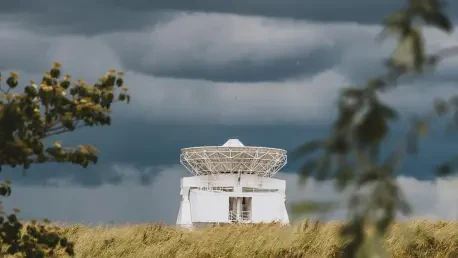The launch of MetOp-SG-A1 on August 13 from Europe’s Spaceport in Kourou, French Guiana, represents a pivotal moment in the evolution of weather forecasting and environmental monitoring, setting a new benchmark for addressing global challenges like extreme weather and climate change with cutting-edge technology. This first satellite of the MetOp Second Generation series, propelled into polar orbit by the powerful Ariane 6 rocket, is poised to transform the accuracy and timeliness of weather predictions. Beyond mere forecasts, it offers a lifeline to communities and economies battered by increasingly unpredictable weather events. Equipped with state-of-the-art instruments, including the Copernicus Sentinel-5 spectrometer, MetOp-SG-A1 will deliver high-resolution data on atmospheric conditions and pollutants. As the inaugural step in a decades-long mission involving six satellites, this endeavor promises to provide an uninterrupted flow of critical information to scientists, meteorologists, and policymakers, enhancing global resilience in the face of environmental uncertainties.
Unveiling Cutting-Edge Technology
The technological prowess of MetOp-SG-A1 lies in its sophisticated suite of instruments, designed to capture an unprecedented level of detail about Earth’s atmosphere. This satellite, the first A-type in its series, boasts tools like a next-generation infrared atmospheric sounder, a microwave sounder, and a multispectral imaging radiometer, each tailored to measure variables such as temperature, humidity, and cloud cover with remarkable precision. The standout feature, however, is the Copernicus Sentinel-5 spectrometer, which focuses on detecting air pollutants and trace gases like ozone, nitrogen dioxide, and methane. This capability ensures daily global data that can directly influence strategies for pollution control and climate mitigation, providing a clearer picture of environmental health. Such advancements signify a leap forward in how atmospheric data is gathered and analyzed, positioning this satellite as a cornerstone for modern meteorological science and environmental policy.
Beyond its observational tools, MetOp-SG-A1 introduces a groundbreaking approach to sustainability in space technology. A pioneering active disposal system, a first for satellites developed by the European Space Agency (ESA), equips the satellite with an additional thruster to facilitate controlled re-entry and self-destruction at the end of its operational life. This innovation addresses the pressing issue of space debris, ensuring that the satellite does not contribute to the growing clutter in orbit. By setting a new standard for responsible space operations, this feature reflects a forward-thinking mindset that balances technological progress with environmental stewardship. The integration of such a system not only safeguards future missions but also underscores the commitment to maintaining a clean orbital environment, a concern that resonates across the global space community and highlights the mission’s broader implications for sustainable exploration.
Building a Global Partnership
The triumph of MetOp-SG-A1 is deeply rooted in a robust collaborative framework that spans multiple continents and organizations. Spearheaded by ESA and the European Organisation for the Exploitation of Meteorological Satellites (Eumetsat), the mission benefits from the expertise and resources of the European Commission through its Copernicus program. Industry leaders, such as Airbus Defence and Space, have played a critical role in developing key components like the Sentinel-5 instrument, ensuring top-tier quality and innovation. This partnership extends its reach through contributions to the Joint Polar System with the U.S. National Oceanic and Atmospheric Administration (NOAA), amplifying the mission’s impact on a global scale. Such international cooperation exemplifies how shared goals and combined expertise can tackle complex challenges, setting a precedent for future collaborative endeavors in space-based Earth observation.
This collaborative spirit is further evidenced by the diverse stakeholder perspectives that highlight the mission’s significance. ESA’s leadership has emphasized the role of strong partnerships in achieving this milestone, noting the satellite’s potential to address erratic weather patterns through precise data. Eumetsat officials have underscored the life-saving implications of the information MetOp-SG-A1 will provide, viewing it as a vital tool for enhancing resilience against climate-driven disasters. Meanwhile, representatives from the European Commission have pointed to the actionable environmental insights offered by the Sentinel-5 instrument, which will inform policies on pollution and climate change. These varied viewpoints converge on a singular truth: the mission’s success is a collective achievement that promises widespread benefits, from improved forecasting accuracy to better-informed global environmental strategies, demonstrating the power of unity in advancing scientific progress.
Strengthening Disaster Preparedness
One of the most profound impacts of MetOp-SG-A1 lies in its ability to bolster resilience against the escalating threat of climate-driven disasters. By orbiting Earth every 100 minutes in a pole-to-pole trajectory, the satellite delivers a near-constant stream of data on atmospheric conditions, enabling meteorologists to predict severe weather events such as storms, floods, and heatwaves with greater accuracy. This timely information is crucial for national weather services to issue early warnings, allowing communities to prepare and respond effectively. The economic and human toll of extreme weather, which has cost billions and claimed countless lives in Europe over recent decades, underscores the urgency of such capabilities. With this satellite’s data, the potential to mitigate these devastating impacts grows significantly, offering a critical tool for safeguarding lives and livelihoods in an era of increasing environmental uncertainty.
Moreover, the data generated by MetOp-SG-A1 extends beyond immediate weather predictions to support long-term disaster preparedness strategies. The detailed insights into atmospheric patterns and pollutant levels provided by the satellite will aid in developing more robust climate models, which are essential for anticipating future risks and planning adaptive measures. Policymakers can leverage this information to craft informed responses to environmental challenges, from urban planning adjustments to public health initiatives addressing air quality concerns. This comprehensive approach to data utilization ensures that the benefits of the mission permeate various sectors, enhancing overall societal resilience. As extreme weather events become more frequent and intense, the role of such advanced satellite technology in fortifying global defenses against these threats cannot be overstated, marking a significant step toward a safer, more prepared world.
Complementing a Broader Observation Network
MetOp-SG-A1 operates within a larger ecosystem of Earth observation systems, complementing Europe’s geostationary Meteosat satellites to provide a holistic view of the planet’s weather dynamics. While Meteosat satellites, positioned 36,000 kilometers above the equator, focus on monitoring fast-evolving weather systems over specific regions, MetOp-SG-A1’s polar orbit offers a unique perspective by capturing detailed measurements across the entire globe. This dual approach maximizes the effectiveness of forecasting models, combining broad, real-time coverage with in-depth, global data. The synergy between these systems ensures that no aspect of Earth’s atmosphere goes unmonitored, providing meteorologists with the comprehensive information needed to refine predictions and respond to emerging weather threats with unparalleled precision.
This integrated observation strategy also enhances the ability to address interconnected environmental issues, such as air pollution and climate variability. The data from MetOp-SG-A1, particularly through the Sentinel-5 instrument, complements the regional insights from geostationary satellites by offering a global snapshot of atmospheric composition. This combined perspective is vital for understanding how local weather patterns interact with broader climate trends, informing both short-term responses and long-term environmental policies. The collaboration between polar and geostationary systems exemplifies a strategic approach to Earth monitoring, ensuring that the complexities of atmospheric behavior are captured in their entirety. As a result, the mission contributes to a more nuanced understanding of the planet’s environmental challenges, paving the way for more effective solutions tailored to diverse regional and global needs.
Pioneering Future Advancements
MetOp-SG-A1 serves as the vanguard for the broader MetOp Second Generation series, laying the groundwork for subsequent launches that will further enhance weather forecasting capabilities. The next milestone, the launch of MetOp-SG-B1 next year, will introduce a complementary set of instruments focused on aspects like wind patterns and ice cloud formations. Together, the A-type and B-type satellites will provide a comprehensive dataset, covering a wide array of atmospheric and environmental variables essential for accurate predictions and climate modeling. This long-term vision, spanning multiple launches over the coming decades, ensures that the advancements initiated by MetOp-SG-A1 will evolve and adapt to meet the growing challenges posed by a changing climate, reinforcing the mission’s role as a catalyst for continuous improvement in meteorological science.
Looking ahead, the mission’s emphasis on innovation and sustainability signals a transformative shift in how space-based observation systems are designed and operated. The active disposal system of MetOp-SG-A1 not only addresses current concerns about space debris but also sets a precedent for future missions to prioritize environmental responsibility. As additional satellites in the series come online, the cumulative data and technological refinements will likely inspire new methodologies in weather prediction and climate research. This forward-looking approach positions the MetOp-SG program as a benchmark for future endeavors, encouraging the global space community to integrate sustainability and precision into their missions. The ripple effects of these advancements promise to reshape the landscape of Earth observation, offering tools that will be indispensable for navigating the environmental uncertainties of tomorrow.
Reflecting on a Milestone Achievement
Reflecting on the journey of MetOp-SG-A1, the successful launch on August 13 stands as a testament to human ingenuity and international collaboration. The seamless integration of advanced technology with a shared vision for better weather forecasting and environmental monitoring marks a significant achievement in the annals of space exploration. Stakeholders from various sectors celebrated the precision with which the satellite was placed into polar orbit, a feat that promises to deliver life-saving data for years to come. The dedication to sustainability, evidenced by the innovative disposal system, highlights a conscientious approach that resonates deeply within the scientific community. As the mission transitions into its operational phase with in-orbit verification, the anticipation for the insights it will provide grows, underscoring the profound impact it has already begun to make on global resilience.
Moving forward, the focus shifts to maximizing the potential of the data MetOp-SG-A1 delivers during its initial operations. National weather services and environmental agencies must harness this information to refine forecasting models and develop targeted strategies for disaster mitigation. Collaborative efforts should intensify to ensure the seamless integration of upcoming satellites in the series, building on the foundation laid by this pioneering launch. Policymakers are encouraged to translate the environmental data into actionable policies that address air quality and climate challenges head-on. As the MetOp-SG program progresses, continuous investment in technological innovation and international partnerships will be vital to sustaining its momentum, ensuring that the legacy of this mission endures as a beacon of progress in safeguarding the planet against the unpredictable forces of nature.









